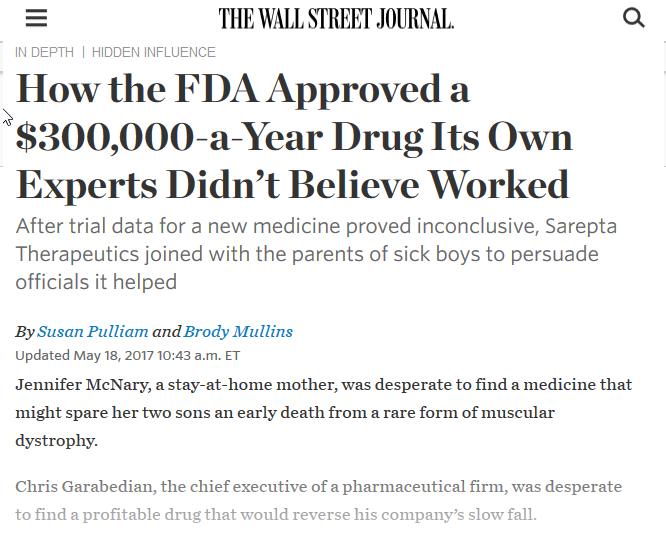
Most of the time, the pharmaceutical conscripts within the FDA will give the ceremonial nod first before a drug is allowed to flood the market. But a recent Wall Street Journal In-depth Report is now saying that sometimes an aggressive lobbying from the drug manufacturers, which have gained support from the patient’s loved ones, can also do the trick.

The WSJ article focuses on the Sarepta Therapeutics’s eteplirsen to treat Duchenne muscular dystrophy [DMD] – a rare genetic disorder characterized by progressive muscle degeneration and weakness. DMD is caused by an absence of dystrophin, a protein that helps keep muscle cells intact. Symptom onset is in early childhood, usually between ages 3 and 5, and occurs mostly in boys.
The authors Susan Pulliam and Brody Mullins found out that:
- In 2012…, it wasn’t at all clear the firm’s drug worked. Faced with government skepticism, a consultant to Mr. Garabedian’s company helped Ms. McNary and other parents prepare slickly packaged testimony to convince the Food and Drug Administration that the drug was helping their sick children, according to parents, company managers and the consultant.
- The company, Sarepta Therapeutics Inc., leveraged the emotional appeal of the parents’ stories. Without that, the drug—eteplirsen—likely wouldn’t have been approved, said stock analysts, investors and people close to the matter.
- Companies that need Washington have turned to new, often untraceable tools—including hidden involvement with grass-roots organizations—to lobby decision makers and help sway public opinion.
- An FDA advisory committee voted 7-6 last year to oppose the drug’s approval, a position later overruled. The Wall Street Journal found that a majority didn’t know how Sarepta’s consultant had guided the patients’ families.
- In February 2013, Ms. McSherry and Ms. McNary met with FDA officials and other patient advocates. A 2012 law encouraged the FDA to be flexible when considering applications for therapies to treat such life-threatening diseases as DMD. Ms. McNary brought a petition with more than 170,000 signatures asking the FDA to expedite approval.
- That day, the two mothers met Janet Woodcock, the FDA’s director of the Center for Drug Evaluation and Research. Dr. Woodcock told them to call her office anytime.
- “Janet had the attitude that if the public called on her, she would take a meeting if she could,” Ms. McSherry said. She and Ms. McNary met with Dr. Woodcock and two other top FDA officials in April 2013. Ms. McNary talked about how the drug was helping Max and showed a video of him walking. Ms. McSherry said the FDA told the women to collect more videos, and that even showing how a child could better comb his hair was important.
- In August, Sarepta put out a release trumpeting an academic paper on the results of its eteplirsen trial. The paper, published in a neurology journal, said weekly treatments showed a statistically significant increase in dystrophin
- By fall 2013, however, the Sarepta campaign suffered a setback. A competitor, GlaxoSmithKline PLC, had completed three trials of a DMD drug that, similarly to eteplirsen, also sought to raise levels of the protein dystrophin. Results of the trials, involving 290 patients, weren’t persuasive.
- “Any effect on dystrophin appears to be small as to be unlikely to have resulted in clinical benefit,” the FDA said later in agency documents.
- On July 14, 2016, Dr. Woodcock, who seldom interceded in drug-approval decisions, overruled both the advisory committee and the FDA review team. In a memo, she said she believed eteplirsen was “reasonably likely to predict clinical benefit.” She declined through a spokeswoman to comment further on her decision.
- Unger appealed to an FDA committee that reviews such disputes saying that eteplirsen was a “scientifically elegant placebo,” giving “false hope in exchange for hardship and risk.” He said it would appear to the public that “unprecedented lobbying efforts” had earned eteplirsen its accelerated approval.
- The head of the FDA committee said she agreed with Dr. Unger’s conclusion that the data didn’t show the drug was “reasonably likely” to provide a clinical benefit, according to agency documents. The dispute was sent to Dr. Califf, the FDA commissioner at the time. He deferred to Dr. Woodcock’s “judgment and authority,” an agency memo said.
- On Sept. 19, the FDA had approved eteplirsen. Within days, company shares more than doubled to $60.
- In December, Congress passed a law intended to expedite the FDA’s approval process for new drugs and allowing companies to provide patient input and other information to bolster clinical data.
- Sarepta shares have dropped back to $35. Some insurance companies refuse to cover the drug. A label on the medicine—renamed Exondys 51—says a clinical benefit of the drug “has not been established.”
“Sarepta used the parents to push their regulatory agenda.
We were willing participants, but they were trading on our desperation.” Catherine Collins, parent of a son who has DMD.
Looking at the bigger picture, we can see that it’s a mainstream medium, i.e. Wall Street Journal, which is taking on the product of a competitor to GlaxoSmithKline, one of Big Pharma’s highly profitable tentacles.
Is it possible that Sarepta Therapeutics may have found a real cure for DMD, and that Big Pharma just don’t want it to be marketed so as not to defeat the purpose by which aluminum and mercury are being blended into their vaccines?
This is a nasty game we are being forced to play on.
Ignore the fearmongering. Produce your own food. Establish your own source of clean water. Try healthcare options that are based on sound, commonsensical and verifiable science.
Don’t be fooled by any aggressive, high profile corporate marketing tactics. Only your own unbiased research will lead you to the cure.
